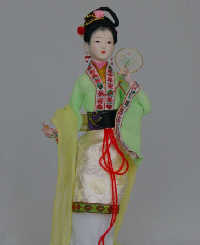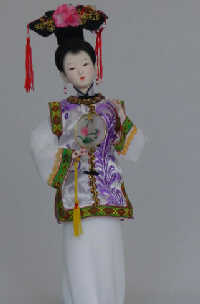 Made of thin silk, gauze, damask silk, etc, silk figurines produced inBeijingare a Chinese traditional handicraft. Folk cloth-pinpricked and color-pricked toys and other handicrafts are all closely connected with handcrafting silk figurines. The trade of silk and knit goods, which has existed in China since ancient times, created an optimal environment for the birth of silk figurines.
Made of thin silk, gauze, damask silk, etc, silk figurines produced inBeijingare a Chinese traditional handicraft. Folk cloth-pinpricked and color-pricked toys and other handicrafts are all closely connected with handcrafting silk figurines. The trade of silk and knit goods, which has existed in China since ancient times, created an optimal environment for the birth of silk figurines.
Beijing silk figurines originated in theNorthern Song Dynasty(960-1127) and have a history of more than 1,000 years. In ancient times, the Chinese used bamboo andpaperas materials for various kinds of craftworks.
 As early as in theTang Dynasty(618-907), color-pricked handicrafts were prevalent in the southern countryside of Southeast China'sFujian Province. In the beginning, people used paper to make different kinds of birds, beasts, flowers and fish. Later, they borrowed themes from popular drama stories and legends and turned them into flowerlanternsfor display. Gradually, this handicraft underwent many improvements. Written records show that folk artists of the Northern Song Dynasty were able to shape damask silk to form human figures, and made clothes from brocade.
As early as in theTang Dynasty(618-907), color-pricked handicrafts were prevalent in the southern countryside of Southeast China'sFujian Province. In the beginning, people used paper to make different kinds of birds, beasts, flowers and fish. Later, they borrowed themes from popular drama stories and legends and turned them into flowerlanternsfor display. Gradually, this handicraft underwent many improvements. Written records show that folk artists of the Northern Song Dynasty were able to shape damask silk to form human figures, and made clothes from brocade.
In theQing Dynasty(1644-1911), thin silk, gauze and damask were made into such images as the God of Longevity and Ma Gu, the Goddess of Longevity, to give as birthday presents to an elder. And this kind of craftwork often appeared in the houses of high officials. However, it is a pity that the craft perished for many years, only to be revived in 1954.
